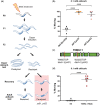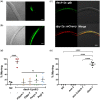A genetic screen for aldicarb resistance of Caenorhabditiselegans dauer larvae uncovers 2 alleles of dach-1, a cytochrome P450 gene
- PMID: 36194018
- PMCID: PMC9713407
- DOI: 10.1093/g3journal/jkac266
A genetic screen for aldicarb resistance of Caenorhabditiselegans dauer larvae uncovers 2 alleles of dach-1, a cytochrome P450 gene
Abstract
Animals exhibit phenotypic plasticity through the interaction of genes with the environment, and little is known about the genetic factors that change synaptic function at different developmental stages. Here, we investigated the genetic determinants of how animal's sensitivity to drugs that alter synaptic activity is regulated at a specific developmental stage using the free-living nematode Caenorhabditis elegans. C. elegans enters the stress-resistant dauer larval stage under harsh conditions. Although dauer is known to have reduced permeability and increased resistance to most known exogenous chemicals, we discovered that dauer is hypersensitive to a cholinesterase inhibitor, aldicarb. To investigate genes regulating dauer-specific acetylcholine transduction, we first screened for aldicarb-resistant mutations in dauer and then performed a secondary screen to rule out aldicarb-resistant mutations that also affect adults. We isolated 2 different mutations of a single gene called cyp-34A4 or dach-1 encoding a cytochrome P450. In the nondauer stages, dach-1 is mainly expressed in the intestine, but its expression is robustly increased in the epidermis of dauers. By tissue-specific rescue experiments, we found that dach-1 modulates aldicarb sensitivity in a cell nonautonomous manner. In addition, dach-1 plays pleiotropic functions in dauers by regulating quiescence and surviving heat shock and hyperosmolar stress. Our study reveals novel functions of the cytochrome P450 in synaptic and physiological changes during the developmental plasticity.
Keywords: cyp-34A1; aldicarb; cytochrome P450; dauer; dauer-specific acetylcholine defect-1 (dach-1); phenotypic plasticity.
© The Author(s) 2022. Published by Oxford University Press on behalf of Genetics Society of America.
Figures




Similar articles
-
Natural variation in gene expression in the early development of dauer larvae of Caenorhabditis elegans.BMC Genomics. 2009 Jul 18;10:325. doi: 10.1186/1471-2164-10-325. BMC Genomics. 2009. PMID: 19615088 Free PMC article.
-
The developmental timing regulator HBL-1 modulates the dauer formation decision in Caenorhabditis elegans.Genetics. 2011 Jan;187(1):345-53. doi: 10.1534/genetics.110.123992. Epub 2010 Oct 26. Genetics. 2011. PMID: 20980238 Free PMC article.
-
Phenotypic plasticity and remodeling in the stress-induced Caenorhabditis elegans dauer.Wiley Interdiscip Rev Dev Biol. 2017 Sep;6(5):10.1002/wdev.278. doi: 10.1002/wdev.278. Epub 2017 May 24. Wiley Interdiscip Rev Dev Biol. 2017. PMID: 28544390 Free PMC article. Review.
-
Epidermal Remodeling in Caenorhabditis elegans Dauers Requires the Nidogen Domain Protein DEX-1.Genetics. 2019 Jan;211(1):169-183. doi: 10.1534/genetics.118.301557. Epub 2018 Nov 8. Genetics. 2019. PMID: 30409788 Free PMC article.
-
[Genetics and evolution of developmental plasticity in the nematode C. elegans: Environmental induction of the dauer stage].Biol Aujourdhui. 2020;214(1-2):45-53. doi: 10.1051/jbio/2020006. Epub 2020 Aug 10. Biol Aujourdhui. 2020. PMID: 32773029 Review. French.
References
-
- Cassada RC, Russell RL.. The dauerlarva, a post-embryonic developmental variant of the nematode Caenorhabditis elegans. Dev Biol. 1975;46(2):326–342. - PubMed
Publication types
MeSH terms
Substances
LinkOut - more resources
Full Text Sources
